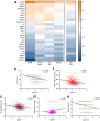Associations between biomarkers of cellular senescence and physical function in humans: observations from the lifestyle interventions for elders (LIFE) study
- PMID: 36367600
- PMCID: PMC9768064
- DOI: 10.1007/s11357-022-00685-2
Associations between biomarkers of cellular senescence and physical function in humans: observations from the lifestyle interventions for elders (LIFE) study
Abstract
Cellular senescence is a plausible mediator of age-associated declines in physical performance. To test this premise, we examined cross-sectional associations between circulating components of the senescence-associated secretory phenotype (SASP) and measures of physical function and muscle strength in 1377 older adults. We showed significant associations between multiple SASP proteins and the short physical performance battery (SPPB), its subcomponents (gait speed, balance, chair rise time), and 400-m walk time. Activin A, ICAM1, MMP7, VEGFA, and eotaxin showed strong associations based on gradient boost machine learning (GBM), and, when combined with other proteins, effectively identified participants at the greatest risk for mobility disability (SPPB score [Formula: see text] 7). Senescence biomarkers were also associated with lower grip strength, and GBM identified PARC, ADAMTS13, and RANTES as top candidates in females, and MMP2, SOST, and MCP1 in males. These findings highlight an association between senescence biomarkers and physical performance in older adults. ClinicalTrials.gov Identifier: NCT01072500.
Keywords: Aging; Biomarkers; Frailty; Physical function; Sarcopenia; Short physical performance battery.
© 2022. The Author(s).
Conflict of interest statement
Mayo Clinic, TAW, and NKL have an intellectual property related to this work. This research has been reviewed by the Mayo Clinic Conflict of Interest Review Board and is being conducted in compliance with Mayo Clinic Conflict of Interest policies.
Figures





References
Publication types
MeSH terms
Substances
Associated data
Grants and funding
LinkOut - more resources
Full Text Sources
Medical
Miscellaneous

